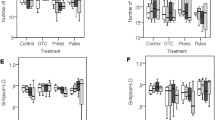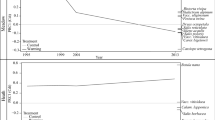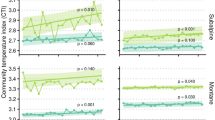Abstract
We experimentally imposed three different kinds of warming scenarios over 3 years on an alpine meadow community to identify the differential effects of climate warming and extreme climatic events on the abundance and biomass of bryophytes and lichens. Treatments consisted of (a) a constant level of warming with open top chambers (an average temperature increase of 1.87 °C), (b) a yearly stepwise increase of warming (average temperature increases of 1.0; 1.87 and 3.54 °C, consecutively), and (c) a pulse warming, i.e., a single first year pulse event of warming (average temperature increase of 3.54 °C only during the first year). To our knowledge, this is the first climate change study that attempts to distinguish between the effects of constant, stepwise and pulse warming on bryophyte and lichen communities. We hypothesised that pulse warming would have a significant short-term effect compared to the other warming treatments, and that stepwise warming would have a significant mid-term effect compared to the other warming treatments. Acrocarpous bryophytes as a group increased in abundance and biomass to the short-term effect of pulse warming. We found no significant effects of mid-term (third-year) stepwise warming. However, one pleurocarpous bryophyte species, Tomentypnum nitens, generally increased in abundance during the warm year 1997 but decreased in control plots and in response to the stepwise warming treatment. Three years of experimental warming (all treatments as a group) did have a significant impact at the community level, yet changes in abundance did not translate into significant changes in the dominance hierarchies at the functional level (for acrocarpous bryophytes, pleurocarpous bryophytes, Sphagnum or lichens), or in significant changes in other bryophyte or lichen species. The results suggest that bryophytes and lichens, both at the functional group and species level, to a large extent are resistant to the different climate change warming simulations that were applied.






Similar content being viewed by others
References
Alatalo JM (1998) Climate change: impacts on structure and biodiversity of subarctic plant communities. PhD thesis, Göteborg University, Sweden. http://hdl.handle.net/2077/16349
Alatalo JM, Little CJ (2014) Simulated global change: contrasting short and medium term growth and reproductive responses of a common alpine/Arctic cushion plant to experimental warming and nutrient enhancement. SpringerPlus 3:157
Alatalo JM, Molau U (1995) Effect of altitude on the sex ratio in populations of Silene acaulis. Nordic J Bot 15:251–256
Alatalo JM, Totland Ø (1997) Response to simulated climate change in an alpine and sub-arctic pollen-risk strategist, Silene acaulis. Glob Change Biol 3:74–79
Arft AM, Walker MD, Gurevitch J et al (1999) Responses of tundra plants to experimental warming: meta-analysis of the International Tundra Experiment. Ecol Monogr 69:491–511
Biasi C, Meyer H, Rusalimova O et al (2008) Initial effects of experimental warming on carbon exchange rates, plant growth and microbial dynamics of a lichen-rich dwarf shrub tundra in Siberia. Plant Soil 307:191–205
Bjerke JW (2010) Winter climate change: ice encapsulation at mild subfreezing temperatures kills freeze-tolerant lichens. Environ Exp Bot 72:404–408
Bjerke JW, Bokhorst S, Zielke M et al (2011) Contrasting sensitivity to extreme winter warming events of dominant sub-Arctic heathland bryophyte and lichen species. J Ecol 99:1481–1488
Bokhorst S, Huiskes A, Convey P et al (2007) The effect of environmental change on vascular plant and cryptogam communities from the Falkland Islands and the Maritime Antarctic. BMC Ecol 7:1–13
Bokhorst S, Huiskes A, Convey P et al (2011) Microclimate impacts of passive warming methods in Antarctica: implications for climate change studies. Polar Biol 34:1421–1435
Bragazza L (2008) A climatic threshold triggers the die-off of peat mosses during an extreme heat wave. Glob Change Biol 14:2688–2695
Chapin FS III, Shaver GR, Giblin AE et al (1995) Responses of arctic tundra to experimental and observed changes in climate. Ecology 76:694–711
Chapin FS III, Bret-Harte MS, Hobbie SE et al (1996) Plant functional types as predictors of transient responses of arctic vegetation to global change. J Veg Sci 7:347–358
Cornelissen JHC, Callaghan TV, Alatalo JM et al (2004) Global change and arctic ecosystems: is lichen decline a function of increases in vascular plant biomass? J Ecol 89:984–994
De Boeck HJ, Dreesen FE, Janssens IA, Nijs I (2010) Climatic characteristics of heat waves and their simulation in plant experiments. Glob Change Biol 16:1992–2000
Dorji T, Totland Ø, Moe SR et al (2013) Plant functional traits mediate reproductive phenology and success in response to experimental warming and snow addition in Tibet. Glob Change Biol 19:459–472
Dormann CF, Woodin SJ (2002) Climate change in the Arctic: using plant functional types in a meta-analysis of field experiments. Funct Ecol 16:4–17
Dugas W, Reicosky D, Kiniry J (1997) Chamber and micrometeorological measurements of CO2 and H2O fluxes for three C4 grasses. Agric For Meteorol 83:113–133
Elmendorf SC, Henry GHR, Hollister RD et al (2012) Global assessment of experimental climate warming on tundra vegetation: heterogeneity over space and time. Ecol Lett 15:164–175
Faul F, Erdfelder E, Buchner A, Lang A-G (2009) Statistical power analyses using G*Power 3.1: tests for correlation and regression analyses. Behav Res Methods 41:1149–1160
Furness SB, Grime JP (1982) Growth rate and temperature responses in bryophytes: II. A comparative study of species of contrasted ecology. J Ecol 70:525–536. doi:10.2307/2259920
Glime JM (2007) Bryophyte ecology. Volume 1, physiological ecology. Chapter 7–1 water relations. Ebook sponsored by Michigan Technological University and the International Association of Bryologists. Accessed 27 May 2014. http://www.bryoecol.mtu.edu/
Graglia E, Jonasson S, Michelsen A et al (2001) Effects of environmental perturbations on abundance of subarctic plants after three, seven and ten years of treatments. Ecography 24:5–12
Hågvar S, Klanderud K (2009) Effect of simulated environmental change on alpine soil arthropods. Glob Change Biol 15:2972–2980. doi:10.1111/j.1365-2486.2009.01926.x
Hallingbäck T, Hedenäs L, Weibull H (2006) Ny checklista för Sveriges Mossor. Svensk Botanisk Tidskrift 100:96–148
Harden JW, Manies KL, Turetsky MR et al (2006) Effects of wildfire and permafrost on soil organic matter and soil climate in interior Alaska. Glob Change Biol 12:2391–2403
Hofmann H, Urmi E, Bisang I et al (2007) Retrospective assessment of frequency changes in Swiss bryophytes over the last two centuries. Lindbergia 32:18–32
Hollister RD, Webber PJ (2000) Biotic validation of small open-top chambers in a tundra ecosystem. Glob Change Biol 6:835–842
Hudson JMG, Henry GHR (2010) High Arctic plant community resists 15 years of experimental warming. J Ecol 98:1035–1041
IPCC (2007) Climate change 2007: impacts, adaptation and vulnerability: working group II contribution to the fourth assessment report of the IPCC intergovernmental panel on climate change. Cambridge University Press, Cambridge
Jägerbrand AK (2007) Effects of an in situ temperature increase on the short-term growth of arctic-alpine bryophytes. Lindbergia 32:82–87
Jägerbrand AK, Molau U, Alatalo JM (2003) Responses of bryophytes to simulated environmental change at Latnjajaure, northern Sweden. J Bryol 25:163–168
Jägerbrand AK, Lindblad KEM, Björk RG et al (2006) Bryophyte and lichen diversity under simulated environmental change compared with observed variation in unmanipulated alpine tundra. Biodivers Conserv 15:4453–4475
Jägerbrand AK, Alatalo JM, Chrimes D et al (2009) Plant community responses to 5 years of simulated climate change in meadow and heath ecosystems at a subarctic-alpine site. Oecologia 161:601–610
Jägerbrand AK, Kudu G, Alatalo JM et al (2012) Effects of neighbouring vascular plants on the abundance of bryophytes in different vegetation types. Polar Sci 6:200–208
Jägerbrand AK, Alatalo JM, Kudo G (2014) Variation in responses to temperature treatments ex situ of the moss Pleurozium schreberi (Willd. ex Brid.) Mitt. originating from eight altitude sites in Hokkaido, Japan. J Bryol. doi:10.1179/1743282014Y.0000000095
Jentsc A, Beierkuhnlein C (2008) Research frontiers in climate change: effects of extreme meteorological events on ecosystems. CR Geosci 340:621–628
Jentsch A, Kreyling J, Beierkuhnlein C (2007) A new generation of climate-change experiments: events, not trends. Front Ecol Environ 5:365–374
Karlsson U (1998) Evaluation of pointframe cover assessment for estimating biomass in alpine tundra. BSc thesis. Göteborg University, Sweden
Klanderud K (2008) Species-specific responses of an alpine plant community under simulated environmental change. J Veg Sci 193:363–372
Knapp AK, Yavitt JB (1992) Evaluation of a closed-chamber method for estimating methane emissions from aquatic plants. Tellus B 44:63–71
Lang SI, Cornelissen JHC, Shaver GR et al (2012) Arctic warming on two continents has consistent negative effects on lichen diversity and mixed effects on bryophyte diversity. Glob Change Biol 18:1096–1107. doi:10.1111/j.1365-2486.2011.02570.x
Longton RE (1984) The role of bryophytes in terrestrial ecosystems. J Hattori Bot Lab 55:147–163
Makkonen M, Berg MP, van Hal JR et al (2011) Traits explain the responses of a sub-arctic Collembola community to climate manipulation. Soil Biol Biochem 43:377–384. doi:10.1016/j.soilbio.2010.11.004
Marion GM, Henry GHR, Freckman DW et al (1997) Open-top designs for manipulating field temperatures in high-latitude ecosystems. Glob Change Biol 3:20–32
Moberg R, Holmåsen I (1990) Lavar, 3rd edn. Interpublishing, Stockholm
Molau U (2001) Tundra plant responses to experimental and natural temperature changes. Memoirs Natl Inst Polar Res Spec Issue 54:445–466
Molau U (2010) Long-term impacts of observed and induced climate change on tussock tundra near its southern limit in northern Sweden. Plant Ecol Divers 3:29–34
Molau U, Alatalo JM (1998) Responses of subarctic-alpine plant communities to simulated environmental change: biodiversity of bryophytes, lichens and vascular plants. Ambio 27:322–329
Nie D, He H, Mo G et al (1992) Canopy photosynthesis and evapotranspiration of rangeland plants under doubled carbon dioxide in closed-top chambers. Agric For Meteorol 61:205–217
Oechel WC, Collins NJ (1976) Comparative CO2 exchange patterns in mosses from two tundra habitats at Barrow, Alaska. Can J Bot 54:1355–1369. doi:10.1139/b76-148
Oksanen J, Guillaume Blanchet F, Kindt R et al (2013) Community ecology package, package ‘vegan’ version 20-7. URL http://cran.r-project.org, http://vegan.r-forge.r-project.org. Accessed 19 March 2013
Olsrud M, Melillo JM, Christensen TR et al (2004) Response of ericoid mycorrhizal colonization and functioning to global change factors. New Phytol 162:459–469
Pauli H, Gottfried M, Dullinger S et al (2012) Recent plant diversity changes on Europe’s mountain summits. Science 336:353–355
Polunin N (1951) The real Arctic: suggestions for its delimitation, subdivision and characterization. J Ecol 39:308–315
Potter JA, Press MC, Callaghan TV et al (1995) Growth responses of Polytrichum commune and Hylocomium splendens to simulated environmental change in the sub-arctic. New Phytol 131:533–541
Press M, Potter J, Burke M et al (1998) Responses of a subarctic dwarf shrub heath community to simulated environmental change. J Ecol 86:315–327. doi:10.1046/j.1365-2745.1998.00261.x
Reicosky DC (1990) Canopy gas exchange in the field: closed chambers. Remote Sens Rev 5:163–177
Rinnan R, Stark S, Tolvanen A (2009) Responses of vegetation and soil microbial communities to warming and simulated herbivory in a subarctic heath. J Ecol 97:788–800. doi:10.1111/j.1365-2745.2009.01506.x
Romanovsky VE, Drozdov DS, Oberman NG et al (2010) Thermal state of permafrost in Russia. Permafrost Periglac Process 21:136–155
Scherrer D, Körner C (2011) Topographically controlled thermal-habitat differentiation buffers alpine plant diversity against climate warming. J Biogeogr 38:406–416
Smith MD (2011) The ecological role of climate extremes: current understanding and future prospects. J Ecol 99:651–655
Soudzilovskaia NA, Graae BJ, Douma JC et al (2011) How do bryophytes govern generative recruitment of vascular plants? New Phytol 190:1019–1031
Steduto P, Çetinkökü Ö, Albrizio R, Kanber R (2002) Automated closed-system canopy-chamber for continuous field-crop monitoring of CO2 and H2O fluxes. Agric For Meteorol 111:171–186
Turetsky MR, Bond-Lamberty B, Euskirchen E et al (2012) The resilience and functional role of moss in boreal and arctic ecosystems. New Phytol 196:49–67
Underwood AJ (1994) On beyond BACI: sampling designs that might reliably detect environmental disturbances. Ecol Appl 4:3–15
Van Wijk MT, Clemmensen KE, Shaver GR et al (2003) Long-term ecosystem level experiments at Toolik Lake, Alaska, and at Abisko, Northern Sweden: generalizations and differences in ecosystem and plant type responses to global change. Glob Change Biol 10:105–123. doi:10.1046/j.1529-8817.2003.00719.x
Vitt DH, Pakarinen P (1977) The bryophyte vegetation production and organic components of Truelove Lowland. In: Bliss LC (ed) Truelove Lowland, Canada: a high Arctic ecosystem. University of Alberta Press, Edmonton, pp 225–244
Walker MD (1996) Community baseline measurements for ITEX studies. In: Molau U, Miolgaard P (eds) ITEX Man, 2nd edn. Danish Polar Centre, Copenhagen, pp 39–41
Walker MD, Wahren HC, Hollister RD et al (2006) Plant community responses to experimental warming across the Tundra Biome. PNAS 103:1342–1346
Wielgolaski FE, Bliss LC, Svoboda J et al (1981) Primary production of tundra. In: Bliss LC et al (eds) Tundra ecosystems: a comparative analysis. Cambridge University Press, Cambridge, pp 187–226
Acknowledgments
The authors thank two anonymous reviewers and Christian Rixen for their comments that improved the manuscript. We thank the staff of Abisko Scientific Research Station for help and hospitality, Vivian Aldén, Björn Aldén and Olga Khitun for assistance in the field. This study was supported by an NFR grant (B-AA/BU 08424) to UM.
Author information
Authors and Affiliations
Corresponding author
Additional information
This article is part of the special issue Vegetation in cold environments under climate change.
Electronic supplementary material
Below is the link to the electronic supplementary material.
Supplemental Information
Supplemental information for this article (Figs. S1, S2 and Table S1) can be found online at:
Fig. S1
Boxplots of abundance on species level of bryophytes after different warming treatments and years at Latnjajaure. A) Anthelia juratzkana, B) Aulacomnium turgidum, C) Blepharostoma trichophyllum, D) Dicranum elongatum, E) Dicranum groenlandicum, F) Hylocomium splendens, G) Polytrichum strictum, H) Ptilidium ciliare, and I) Sphagnum warnstorfii. Treatments: control (Control), constant warming enhancement using open-top chambers (OTC), a stepwise increase in the magnitude of warming (Step) and a single-summer high-impact warming event (Pulse). Boxplots show the 10th to 90th percentile of the data; n = 4 plots per treatment. Supplementary material 1 (DOCX 2,626 kb)
Fig. S2
Boxplots of the abundance at the species level for lichens after different warming treatments and years at Latnjajaure Field Station. A) Cladina arbuscula, B) Cladonia uncialis, C) Ochrolechia frigida, and D) Sphaerophorus globosus. Treatments: control (Control), constant warming using open-top chambers (OTC), a stepwise increase in the magnitude of warming (Step) and a single-summer high-impact warming event (Pulse). Boxplots show the 10th to 90th percentile of the data; n = 4 plots per treatment. Supplementary material 2 (DOCX 1,173 kb)
Rights and permissions
About this article
Cite this article
Alatalo, J.M., Jägerbrand, A.K. & Molau, U. Climate change and climatic events: community-, functional- and species-level responses of bryophytes and lichens to constant, stepwise, and pulse experimental warming in an alpine tundra. Alp Botany 124, 81–91 (2014). https://doi.org/10.1007/s00035-014-0133-z
Received:
Accepted:
Published:
Issue Date:
DOI: https://doi.org/10.1007/s00035-014-0133-z




